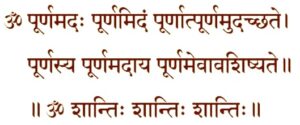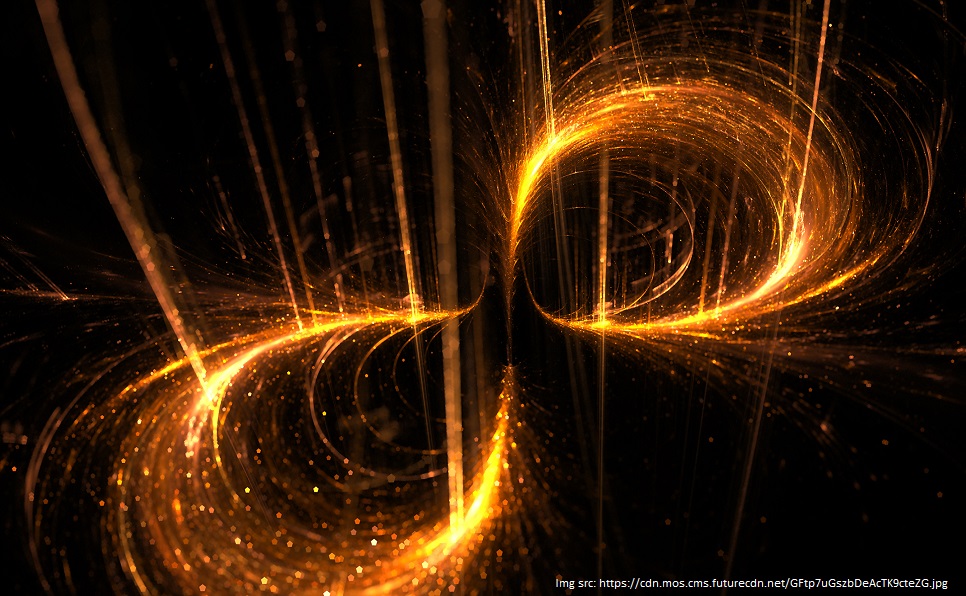The first part covered understanding the meaning of the first line of the verse Om Purnamadah Purnamidam. It showed how completeness (purnam) indicated by aham (I) and idah (this) cannot have form despite our formful experience. We also covered how the above conclusion is logical and not a matter of belief. In this part, we will deep-dive into the meaning of other lines in the verse.

Purnat purnam udachyate
The above line is translated as:
From completeness, completeness comes forth.
Considering the above translation and analysis in part 1, the meaning turns out to be:
From completeness – Here the completeness refers to ‘I’ (adah) – the limitless brahman. This brahman is also the efficient and material cause of creation.
Completeness comes forth – Here the completeness refers to ‘this’ (Idam) – the known and knowable objects comprising the word, the effect called creation
Thus, the verse sets up a causal relationship of material cause and effect between formless ’I’ and formful ’this’.
Can a world of formful objects come from formless?
The limitlessness of brahman requires it to be formless. This verse says that the completeness comprising the world of formful objects came from completeness (I), which is formless.
Limitlessness does not allow two completeness – formful and formless. Did the formless completeness, I (cause) undergo a change to become formful completeness, this (Effect)?.
What kind of change can formless limitless undergo to produce formful limitless? The only kind of change that the limitless can accommodate is the kind of change that gold undergoes to become a chain. From formless gold (an unshaped quantity of gold), a formful chain is produced. There is no real chain in the gold itself. From gold, gold comes forth. There is no change. Similarly from completeness, completeness comes forth.
The last two lines of the verse
Purnasya purnam adaya
Purnam eva avashisyate
The above two lines are translated as:
Taking away completeness from completeness, adding completeness to completeness
Completeness alone remains
In context, the meaning is whether you take away this (idam) i.e. formful object completeness (purnam) from I (adah) i.e. formless Brahman completeness (purnam) or whether you add this (idam) completeness (purnam) to I (adah) completeness, all that is there all that ever remains, is completeness (purnam) alone.
Absence of difference between two objects of the world:
To understand the oneness of objects in the world, take the example of gold chain. If you have a gold chain and take the chain away, gold remains. Similarly, If you make a gold chain from gold, gold remains. The second half of the verse needed to emphasize that completeness undergoes no change whatsoever. It is always there.
Just as a chain is no different from gold, in the same way the objects of the world are not different from the limitless Brahman i.e. completeness. Addition of this (idam) i.e. the objects comprising creation, to completeness (purnam) i.e. the formless, limitless, Brahman (idah, I), does not make any addition to Brahman (idah I). Similarly taking away this (idam) i.e. the objects comprising creation, from completeness (purnam) i.e. Brahman does not eliminate anything from completeness i.e. Brahman.
The mention of “adding to” and “taking away from” completeness is done in order to discover limitlessness i.e. to discover that I (idah) am that limitless which I long to be. Any ’adding to’ or ’taking away from’ is purely an appearance. There is no real different thing to add to or take away from another different thing. All differences between objects, between subject and object, between formless and formfull is superficial. Difference is just an appearance but lacks reality.
Understanding through an example of a dream one can conclude that from me alone came the dreamer subject and the dreamt object. On removing the dreamer and the dreamt, I alone remain. The dreamer subject and the dream resolve in me.
A knowable thing, anything which can be objectified has no reality of its own. Things are limited by time and space. They are dependent for their apparent reality upon a substratum. That substratum is formless, limitless, time-free Brahman. Thus, when I pick up stone from a stream of water, I enjoy the apparent difference between rock and water. But at the same time, I can also see and appreciate the fact of non-difference between these two. The duality of stone and water resolves into a single nondual reality Brahman.
Absence of difference between I (seer) and object (seen):
The absence of difference between two objects of this world is easier to understand compared to the difference between I (seer) and object (seen). I see the stone outside because my skin divides me from the world.
My skin is part of and the boundary for a given physical body and its functions. This body is a known thing i.e. something objectifiable. Associated with this body and its functions is a certain bundle of thoughts. Each of these thoughts is also known i.e. objectifiable. No thought or any collection of thoughts is non-objectifiable.
All objects, all events, this body, mind, memory, sense of agency and interval measuring time as well as accommodating space – all are known or knowable. Thus, no real difference can be established between the seer and the seen. The only difference between known things is the apparent difference of ever changing name-forms projected upon the never changing formless reality of Brahman (completeness).
Thus, the difference between seer and seen have no independent reality. They are apparent and are negatable by gaining knowledge. The subject/object differences encountered in experience is not eliminated as experience but is negated as nonreal through knowledge.
A dream is good example of the ’realness’ of experienced difference within its own level of reality. If I dream of a fire which I am trying to put out by throwing water on it, then that dream water which puts out the dream fire is as real as the fire – and the fire is as real as the water. And I, the dream firefighter, am as real as the water and the fire. But I am no more real than the fire or water. Enjoying the same degree of reality, the fire fighter, the fire, the water, all seem real, all seem different, but all resolve as unreal. Upon waking I find no ashes on my bedroom floor. Dreamer and dreamt have both resolved. Dreamer has no greater reality than dreamt. Nothing is left out. I alone remain.
This one verse has everything. Nothing is left out. Subject, object, cause, effect, experience and fullness – nothing is omitted. It contains the truth of oneself.
Summary
In reality I am limitlessness alone, one non-dual existent boundless consciousness purnam. Subject and object are nothing but passing projections superimposed upon I. They neither add to I nor take anything away from I. I, unconnected to any appearance, am the One unchanging, non-negatable formless reality – purnam – into which all appearances resolve.
The differences that appear are not real and do not impose any limitation upon me. They are manifestations of me and resolve in me. Whatever remains is I (completeness).
Reference: Commentary on Purnamadah Purnamidam: Swami Dayanand Saraswati


